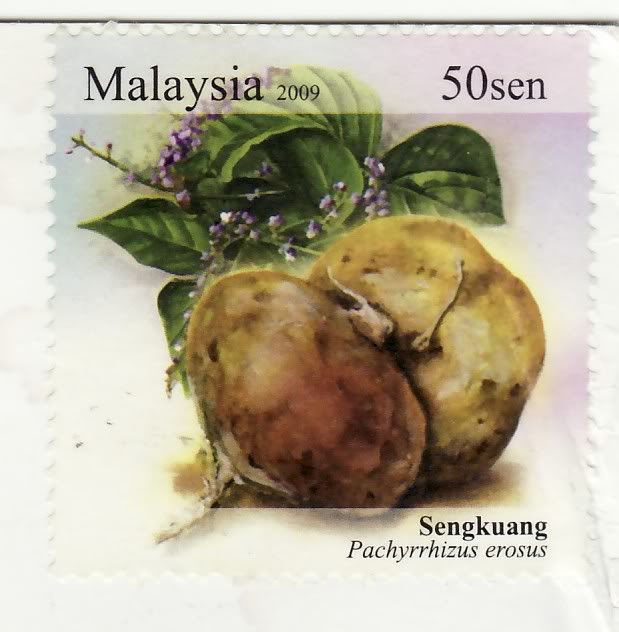Date of Issue : 23rd July 2009
Stamp Value : 30 sen (2 Designs), 50 sen (2 Designs)
Designer : World Communications Network Resources Sdn. Bhd.
Set: Tuber Plants
The term tuber plants or root crops is applied to plants which produce subterranean structures that are used as human or animal foods. These perennial plants have organs which store plant nutrients. In many cases the storage organs may be a root or a modified stem, for example a swollen rhizome or corm, or a tuber such as a potato or a swollen root as in carrot or sweet potato. All these swollen underground organs are commonly spoken of as tubers.
Root crops are the second most important source of carbohydrates in the worlds food, the most important being cereals. However, in the tropical world, root crops are proportionally much more important. In fact, in many tropical countries where rice is not grown, they are the staple diet. In general the protein content is low, but some, like potato and yam provide significant amounts of certain vitamins.
Sengkuang (Pachyrrhizus erosus)
Sengkuang is one species in the genus Pachyrrhizus that is commonly called yam bean.
The sengkuang vine can reach a height f 4-5 metres, given suitable support. Its roots can attain length of up to 2 metres and weigh up to 20 kilograms. The roots exterioris yellowishbrown while its inside is creamy white with a crisp textile that resembles water chestnut or pear.
In contrast to the roots, the remainder of the sengkuang plant is very poisonous; the seeds contain the toxin rotenone, which is used to kill insects and stun fish.
Sengkuang is high in carbohydrates and dietary fiber. It is composed of 86-90% water, containing only trace amounts of protein and lipids. Its sweet flavour makes it a favourite ingredient in rojak and popiah.http://stampbooks.blogspot.com
Stamp Value : 30 sen (2 Designs), 50 sen (2 Designs)
Designer : World Communications Network Resources Sdn. Bhd.
Set: Tuber Plants
The term tuber plants or root crops is applied to plants which produce subterranean structures that are used as human or animal foods. These perennial plants have organs which store plant nutrients. In many cases the storage organs may be a root or a modified stem, for example a swollen rhizome or corm, or a tuber such as a potato or a swollen root as in carrot or sweet potato. All these swollen underground organs are commonly spoken of as tubers.
Root crops are the second most important source of carbohydrates in the worlds food, the most important being cereals. However, in the tropical world, root crops are proportionally much more important. In fact, in many tropical countries where rice is not grown, they are the staple diet. In general the protein content is low, but some, like potato and yam provide significant amounts of certain vitamins.
Sengkuang (Pachyrrhizus erosus)
Sengkuang is one species in the genus Pachyrrhizus that is commonly called yam bean.
The sengkuang vine can reach a height f 4-5 metres, given suitable support. Its roots can attain length of up to 2 metres and weigh up to 20 kilograms. The roots exterioris yellowishbrown while its inside is creamy white with a crisp textile that resembles water chestnut or pear.
In contrast to the roots, the remainder of the sengkuang plant is very poisonous; the seeds contain the toxin rotenone, which is used to kill insects and stun fish.
Sengkuang is high in carbohydrates and dietary fiber. It is composed of 86-90% water, containing only trace amounts of protein and lipids. Its sweet flavour makes it a favourite ingredient in rojak and popiah.http://stampbooks.blogspot.com

No comments:
Post a Comment